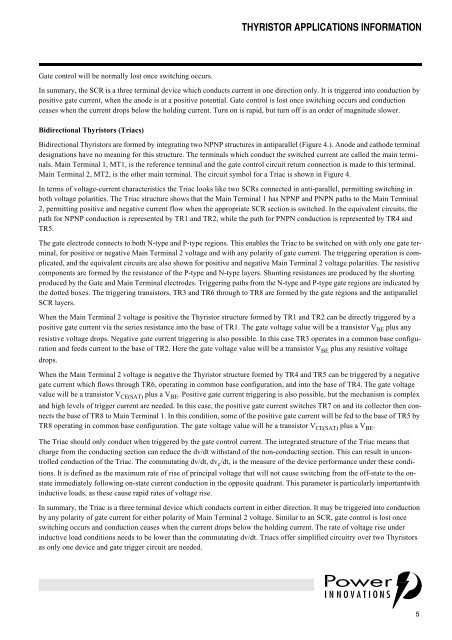Thyristors - Theory, Parameters and Applications
Thyristors - Theory, Parameters and Applications
Thyristors - Theory, Parameters and Applications
Create successful ePaper yourself
Turn your PDF publications into a flip-book with our unique Google optimized e-Paper software.
THYRISTOR APPLICATIONS INFORMATIONGate control will be normally lost once switching occurs.In summary, the SCR is a three terminal device which conducts current in one direction only. It is triggered into conduction bypositive gate current, when the anode is at a positive potential. Gate control is lost once switching occurs <strong>and</strong> conductionceases when the current drops below the holding current. Turn on is rapid, but turn off is an order of magnitude slower.Bidirectional <strong>Thyristors</strong> (Triacs)Bidirectional <strong>Thyristors</strong> are formed by integrating two NPNP structures in antiparallel (Figure 4.). Anode <strong>and</strong> cathode terminaldesignations have no meaning for this structure. The terminals which conduct the switched current are called the main terminals.Main Terminal 1, MT1, is the reference terminal <strong>and</strong> the gate control circuit return connection is made to this terminal.Main Terminal 2, MT2, is the other main terminal. The circuit symbol for a Triac is shown in Figure 4.In terms of voltage-current characteristics the Triac looks like two SCRs connected in anti-parallel, permitting switching inboth voltage polarities. The Triac structure shows that the Main Terminal 1 has NPNP <strong>and</strong> PNPN paths to the Main Terminal2, permitting positive <strong>and</strong> negative current flow when the appropriate SCR section is switched. In the equivalent circuits, thepath for NPNP conduction is represented by TR1 <strong>and</strong> TR2, while the path for PNPN conduction is represented by TR4 <strong>and</strong>TR5.The gate electrode connects to both N-type <strong>and</strong> P-type regions. This enables the Triac to be switched on with only one gate terminal,for positive or negative Main Terminal 2 voltage <strong>and</strong> with any polarity of gate current. The triggering operation is complicated,<strong>and</strong> the equivalent circuits are also shown for positive <strong>and</strong> negative Main Terminal 2 voltage polarities. The resistivecomponents are formed by the resistance of the P-type <strong>and</strong> N-type layers. Shunting resistances are produced by the shortingproduced by the Gate <strong>and</strong> Main Terminal electrodes. Triggering paths from the N-type <strong>and</strong> P-type gate regions are indicated bythe dotted boxes. The triggering transistors, TR3 <strong>and</strong> TR6 through to TR8 are formed by the gate regions <strong>and</strong> the antiparallelSCR layers.When the Main Terminal 2 voltage is positive the Thyristor structure formed by TR1 <strong>and</strong> TR2 can be directly triggered by apositive gate current via the series resistance into the base of TR1. The gate voltage value will be a transistor V BE plus anyresistive voltage drops. Negative gate current triggering is also possible. In this case TR3 operates in a common base configuration<strong>and</strong> feeds current to the base of TR2. Here the gate voltage value will be a transistor V BE plus any resistive voltagedrops.When the Main Terminal 2 voltage is negative the Thyristor structure formed by TR4 <strong>and</strong> TR5 can be triggered by a negativegate current which flows through TR6, operating in common base configuration, <strong>and</strong> into the base of TR4. The gate voltagevalue will be a transistor V CE(SAT) plus a V BE . Positive gate current triggering is also possible, but the mechanism is complex<strong>and</strong> high levels of trigger current are needed. In this case, the positive gate current switches TR7 on <strong>and</strong> its collector then connectsthe base of TR8 to Main Terminal 1. In this condition, some of the positive gate current will be fed to the base of TR5 byTR8 operating in common base configuration. The gate voltage value will be a transistor V CE(SAT) plus a V BE .The Triac should only conduct when triggered by the gate control current. The integrated structure of the Triac means thatcharge from the conducting section can reduce the dv/dt withst<strong>and</strong> of the non-conducting section. This can result in uncontrolledconduction of the Triac. The commutating dv/dt, dv c /dt, is the measure of the device performance under these conditions.It is defined as the maximum rate of rise of principal voltage that will not cause switching from the off-state to the onstateimmediately following on-state current conduction in the opposite quadrant. This parameter is particularly importantwithinductive loads, as these cause rapid rates of voltage rise.In summary, the Triac is a three terminal device which conducts current in either direction. It may be triggered into conductionby any polarity of gate current for either polarity of Main Terminal 2 voltage. Similar to an SCR, gate control is lost onceswitching occurs <strong>and</strong> conduction ceases when the current drops below the holding current. The rate of voltage rise underinductive load conditions needs to be lower than the commutating dv/dt. Triacs offer simplified circuitry over two <strong>Thyristors</strong>as only one device <strong>and</strong> gate trigger circuit are needed.5


